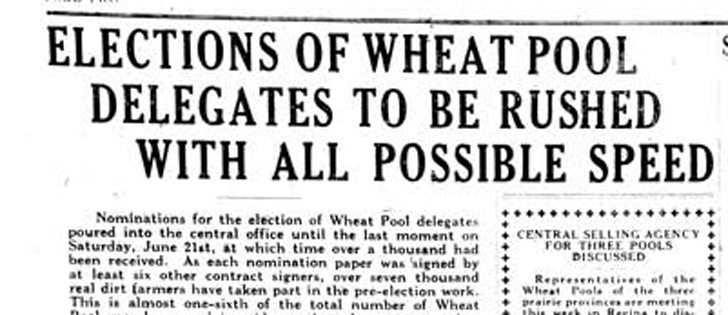NOW:
In its infancy, The Western Producer was the voice of the exploding wheat pool movement on the Prairies.
“The Alberta Pool Campaign Now Forging Ahead Rapidly,” screamed an excited front page headline Aug. 27, 1923.
“The Saskatchewan Wheat Pool — the biggest thing the farmers of Western Canada have ever undertaken is the wheat pool,” said an advertisement for Saskatchewan Co-operative Wheat Producers Ltd. the same year, which matched the drift of the story coverage.
The 1924 Manitoba Pool Elevators’ campaign was equally big news.
Read Also

Farming Smarter receives financial boost from Alberta government for potato research
Farming Smarter near Lethbridge got a boost to its research equipment, thanks to the Alberta government’s increase in funding for research associations.
Then The Western Producer lived long enough to chronicle the demise of the pool movement, first through a move away from the co-operative structure and a decline in farmer control and influence to finally being another grain company like all the others.
And there is an argument in some quarters that the demise of the pools had much broader effects than just a weakening of farmer influence in the industry.
Brian Oleson, for one, is convinced it was a precursor to the demise of the CWB single desk last year.
“The CWB could not survive without the pool democratic structure and farmer buy-in through a sense of ownership,” said the former vice-president of corporate affairs at the board and now with the University of Manitoba.
“The pools, when they dominated the prairie grain industry, gave the board its support base in the countryside.”
Barry Senft, a former second vice-president of Saskatchewan Wheat Pool and now chief executive officer of Grain Farmers of Ontario, is skeptical of that argument.
He said there has been a change in the political and marketing ideology of grain farmers that cleared the way for the end of the board monopoly, despite a core of farmers who remain adamant supporters of the CWB and pool models.
“I don’t know that if the pools were in place today, things would have turned out any different,” Senft said.
“I’d be surprised if it would have changed anything because the pools were changing, too.”
Still, these two former pool and CWB insiders have some theories on why the pools and then the board exited stage right.
Senft remembers when Sask Pool was the dominant provincial grain handler with more than 60 percent of the crop and significant farmer loyalty.
“It really was a sense of entitlement with ‘their’ company,” he said.
“I remember growing up, if the local pool elevator filled and there was space in a competitor elevator, farmers would hold off delivery until there was space in their elevator.”
Senft said Sask Pool’s consolidation program of closing elevators, the increasing power of management and the falling power or influence of farmers in the company eroded that religious-type loyalty.
“There was a sense, I guess, that if they are not loyal to me, I won’t be loyal to them.”
Then the pool became just another marketing option.
The move into investing in companies down the value chain, such as a flour mill and Robin’s Donuts, was also controversial with some members. Senft said it was the right decision but managed badly by the pool.
Oleson has a different take on that attempt to expand the company focus away from the farmer base.
“I remember having a Robin’s coffee one day and really thinking that this was a symbol of how the company was moving away from farmers,” he said.
“It seemed like a metaphor for going down the road to destruction.”
Meanwhile, the grain industry was consolidating and becoming dominated by bigger corporate players. As well, the co-operative structure had a difficult time accumulating the capital it needed for investment and expansion, and farmer politics were changing.
As well, most farmers became more familiar and comfortable doing their own marketing for non-board crops such as canola and pulses as wheat and barley declined as a percentage of prairie production.
“They realized they could learn the marketing, appreciated the cash flow and that affected the attitude,” said Senft.
Farmer numbers were also falling and the political influence declining both within the pool and generally.
He remembers fondly the days when politicians were loathe to announce a grain policy without getting prairie pool blessing.
“Those were the glory days,” he said. “Farmers had power. They felt they could control their market collectively. Obviously this is a different era.”
THEN: Elections of wheat pool delegates to be rushed with all possible speed

Nominations for the election of Wheat Pool delegates poured into the central office until the last moment on Saturday, June 21st, at which time over a thousand had been received. As each nomination paper was signed by at least six other contract signers, over seven thousand real dirt farmers have taken part in the pre-election work. This is almost one-sixth of the total number of Wheat Pool members, and is evidence that the movement has touched the heart of the farmer’s problems as nothing has ever done before.
The alberta pool campaign now forging ahead rapidly
CALGARY, Aug. 22nd. — In all parts of Alberta where wheat is grown, the campaign to secure members in the Alberta Co-operative Wheat Producers, Ltd., to use the corporate name of the Alberta Wheat Pool, commenced on Monday August 20th, and is being carried on with all possible energy and speed. The equivalent of at least 50 per cent. of the Alberta wheat acreage of 1922 must be placed under contract to the Pool, in order to make the contracts binding. Confidence is expressed by those in charge of the drive that much more than the requisite acreage will be obtained.
Download PDFs of the original WP pages here: 1924_jun26_p02 and here: 1923_aug27_p1_FIRST ISSUE

















